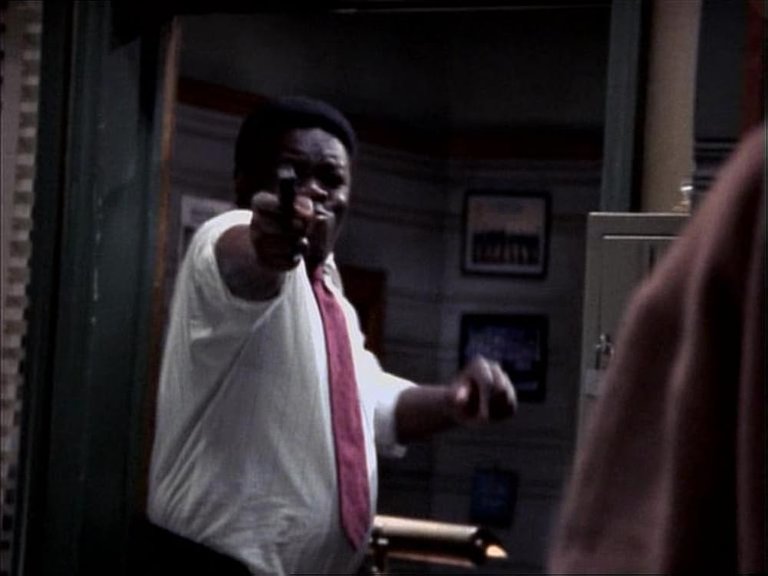
Fallen Heroes: Part I (S06E22)
Airdate: 1 May 1998
Written by: Elle Johnson
Directed by: Kathryn Bigelow
Running Time: 44 minutes
By its penultimate season, Homicide: Life on the Street had transitioned from its early, unflinching portrayal of urban policing’s moral ambiguities to a more conventional police procedural, increasingly prioritising spectacle over substance. This shift reached its zenith in the penultimate season’s finale, Fallen Heroes, which exemplified the series’ capitulation to the heightened, sensationalised storytelling trends dominating American broadcast television in the mid-1990s. Instead of a cohesive standalone episode, the finale was artificially bifurcated into two parts, a narrative choice that strained credibility. The decision to split the story—likely driven by network demands for cliffhangers and prolonged anticipation—revealed the show’s struggle to balance its roots in gritty realism with the demands of mainstream entertainment. Fallen Heroes: Part I thus stands as both a climax and a departure, marking the point at which Homicide sacrificed its unique voice for the sake of ratings-driven theatrics.
The episode’s central plot revolves around a murder so high-profile it is dubbed a “redball” even by seasoned detectives Frank Pembleton and Tim Bayliss, who acknowledge its unprecedented scale. The victim, Judge Gibbons, is killed in broad daylight outside a courthouse—a crime that immediately escalates due to his prominence and the involvement of Colonel Barnfather, a symbol of the political establishment’s demand for swift resolution. The presence of the FBI further amplifies the stakes, as their prior investigation into Gibbons’ corruption ties the case directly to drug lord Georgia Rae Mahoney. This interweaving of institutional power and criminal networks elevates the case beyond the show’s typical gritty realism, leaning instead into procedural tropes of political intrigue and conspiratorial machinations.
The investigation initially proceeds with unexpected ease, as Pembleton and Bayliss quickly apprehend Nathaniel Lee “Junior Bunk” Mahoney (Mekhi Phifer), son of Georgia Rae. His arrest is framed as almost too convenient: released from prison after his mother bribed a victim, Junior Bunk’s transformation from “a scared and confused boy” to a hardened criminal is abrupt yet thematically resonant, underscoring the cyclical nature of Baltimore’s criminal underworld. However, his subsequent escape—enabled by an officer’s negligence—culminates in a chaotic shootout. The resulting violence, which claims three officers’ lives and leaves Detectives Gharty and Ballard critically injured, injects visceral tension. This sequence, while narratively convenient, serves as a grim reminder of the series’ ability to ground action in emotional consequence, even as it leans into melodrama.
Parallel to the Mahoney storyline, Detectives Falsone and Stivers investigate the murder of probation officer Eugene Richmond (Jefferson Russell). Shot inside his own bullet-riddled car, Richmond’s death is revealed to be a contract hit orchestrated by Pony Johnson, a prisoner he had sent back to jail. The subplot, while competently handled, feels tonally mismatched against the main narrative’s operatic stakes. Kevin Corrigan’s performance as the conflicted parolee Carl Curtis adds depth, but the case’s resolution—a rushed confession—feels perfunctory, a narrative afterthought overshadowed by the season’s climactic arc.
Elle Johnson’s script, tasked with wrapping up the Luther Mahoney saga, opts for maximalist storytelling. The murder of Judge Gibbons, a linchpin of institutional authority, is framed as a personal vendetta by Junior Bunk, who allows himself to be captured to incite chaos. This meta-strategy positions him as a pawn in his mother’s war against the police, yet his sudden competence during the escape undermines his earlier portrayal as inept. The episode’s cliffhanger—Gharty’s uncertain survival—serves as a manipulative but effective tool to secure viewers for the second part, though it risks prioritising shock over narrative cohesion. Johnson’s balancing act between character-driven moments and procedural spectacle is uneven, yet her ambition to escalate the series’ stakes is undeniable.
Amid the heightened drama, Johnson deserves credit for ensuring that the characters’ responses to the violence feel grounded. The detectives oscillate between procedural duty and raw emotion: Giardello’s vengeful declaration against Georgia Rae Mahoney feels earned. This attention to emotional authenticity, however fleeting, tempers the script’s excesses, reminding viewers of the show’s enduring strength in humanising its ensemble.
Kathryn Bigelow’s involvement as director, famous for her work in action genre, brings a kinetic energy to the shootouts and tense confrontations, particularly the chaotic climax in the police station. However, her stylistic choices occasionally clash with the show’s grounded tone. A surreal sequence featuring Detective Ballard imagining the shooting Junior Bank and saving her colleague during surgery—a visual flourish meant to evoke hope—feels overly “artsy,” disrupting the episode’s otherwise gritty realism. Bigelow’s focus on action pacing serves the narrative but highlights the tension between the series’ original ethos and its late-season shift towards grandstanding.
A curious meta-moment arises when Bayliss and Pembleton discuss Corner, David Simon’s 1997 non-fiction book about Baltimore’s drug trade. This nod to Simon’s work—author of the 1988 book that inspired the series—serves as trivia-laden fan service rather than meaningful commentary. While it underscores the show’s deep ties to its source material, the exchange feels tacked-on, a reminder that Homicide’s later seasons occasionally prioritised self-referentiality over narrative innovation.
Fallen Heroes: Part I encapsulates Homicide: Life on the Street’s fraught identity crisis. Its blend of procedural theatrics and character-driven drama is uneven, yet it remains a compelling, if flawed, chapter in the series’ legacy. The episode’s excesses—the split finale, the over-the-top violence, the meta-commentary—reflect the pressures of network television, pushing the show further from its roots in social realism. However, its strength lies in its ability to sustain emotional resonance even amid spectacle.
RATING: 6/10 (++)
Blog in Croatian https://draxblog.com
Blog in English https://draxreview.wordpress.com/
InLeo blog https://inleo.io/@drax.leo
Hiveonboard: https://hiveonboard.com?ref=drax
Rising Star game: https://www.risingstargame.com?referrer=drax
1Inch: https://1inch.exchange/#/r/0x83823d8CCB74F828148258BB4457642124b1328e
BTC donations: 1EWxiMiP6iiG9rger3NuUSd6HByaxQWafG
ETH donations: 0xB305F144323b99e6f8b1d66f5D7DE78B498C32A7
BCH donations: qpvxw0jax79lhmvlgcldkzpqanf03r9cjv8y6gtmk9